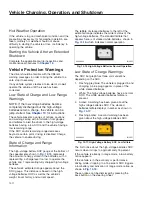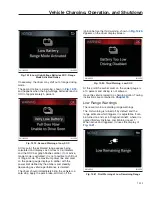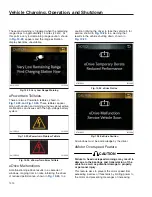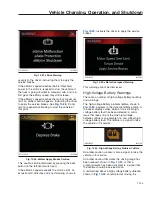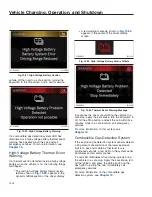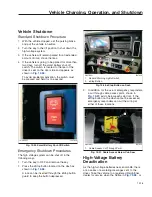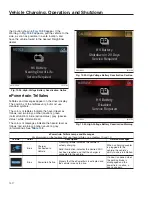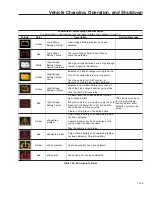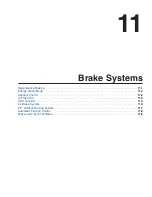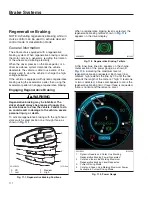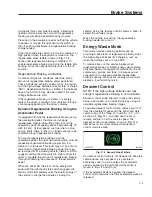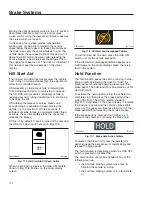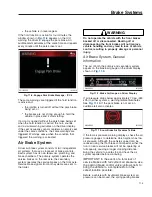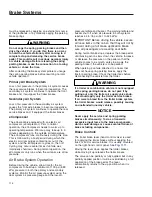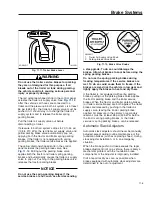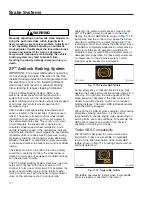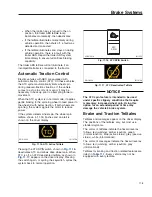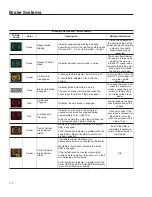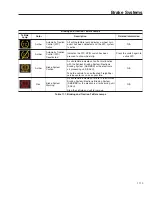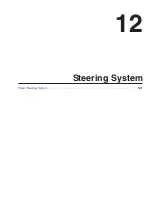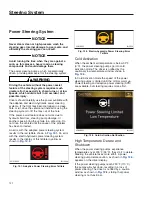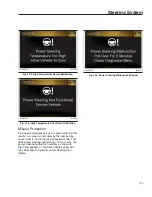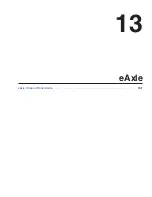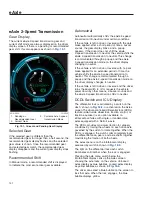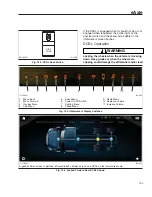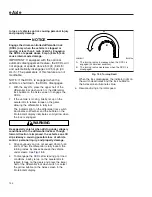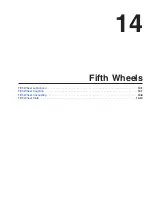
must be released by applying an external air source
at the gladhands, or by manually caging the parking
brake springs.
WARNING
Do not cage the spring parking brakes and then
drive the vehicle. If you do this, there is no way
to hold the vehicle stationary after coming to a
complete stop and releasing the service brake
pedal. This could result in serious personal injury
or vehicle damage. Before releasing the spring
parking brakes, make the connection to a towing
vehicle or chock the tires.
After correcting the brake system problem, uncage
the spring parking brakes before resuming normal
vehicle operation.
Primary Air Brake System
Loss of air pressure in the primary air system causes
the rear service brakes to become inoperative. The
secondary air system continues to operate the front
brakes and, if equipped, the trailer brakes.
Secondary Air System
Loss of air pressure in the secondary air system
causes the front axle brakes to become inoperative.
The primary air system continues to operate the rear
service brakes and, if equipped, the trailer brakes.
eCompressor
The eCascadia is equipped with an electric air
compressor (eCompressor). Prior to normal
operation, the eCompressor needs to warm up to
operating temperature. Warm-up may take up to 5
minutes depending on the outside air temperature.
The eCompressor runs continuously during this time.
This is followed by a brief period during which the
electric air dryer purges contaminants out of the
system, and the eCompressor cycles on, then off.
Cycling may occur several times if vehicle was
improperly shutdown. During normal operation, the
eCompressor only runs when the air tanks are at low
pressure.
Air Brake System Operation
Before driving the vehicle, allow time for the air
compressor to build up a minimum of 100 psi (689
kPa) pressure in both the primary and secondary
systems. Monitor the air pressure system using the
dual system air pressure gauge and the low-air-
pressure telltale and buzzer. The warning telltale and
buzzer shut off when air pressure in both systems
reaches 64 to 76 psi (441 to 524 kPa).
IMPORTANT: Before driving the vehicle, secure
all loose items in the cab so that they will not fly
forward during a full brake application. Make
sure all passengers are wearing seat belts.
During normal brake stops, depress the brake pedal
until braking action slows down the vehicle. Increase
or decrease the pressure on the pedal so that the
vehicle comes to a smooth, safe stop. Apply the
parking brake if the vehicle is to be parked.
When parking a vehicle attached to a trailer that
does not have spring parking brakes, apply the
tractor parking brake. Chock the trailer tires before
disconnecting the vehicle from the trailer.
WARNING
If a trailer or combination vehicle is not equipped
with spring parking brakes, do not park it by
pulling out only the trailer air supply valve knob.
This would apply only the trailer service brakes.
If air were to bleed from the trailer brake system,
the trailer brakes would release, possibly causing
an unattended runaway vehicle.
NOTICE
Never apply the service and spring parking
brakes simultaneously. To do so transmits
excessive input force to the brake components,
which could damage or cause eventual failure of
brake actuating components.
Brake Controls
The trailer brake lever (hand control valve) is used
for applying the trailer brakes without applying the
truck or tractor service brakes. It is usually mounted
on the right-hand control panel. See
Moving the lever down applies the trailer brakes,
while moving it up releases the trailer brakes.
The valve can be partially or fully applied, but in any
partially applied position it will be overridden by a full
application of the brake pedal. The lever
automatically returns to the up position when it is
released.
Brake Systems
11.5
Summary of Contents for PX113064S T 2016
Page 4: ......
Page 10: ......
Page 18: ......
Page 58: ......
Page 86: ......
Page 112: ......
Page 122: ......
Page 142: ......
Page 154: ......
Page 155: ...12 Steering System Power Steering System 12 1...
Page 158: ......
Page 159: ...13 eAxle eAxle 2 Speed Transmission 13 1...
Page 176: ......
Page 190: ......
Page 202: ......
Page 222: ......
Page 223: ...20 Emissions Information Noise Emissions 20 1 Greenhouse Gas Emissions 20 1...
Page 229: ......
Page 236: ......

